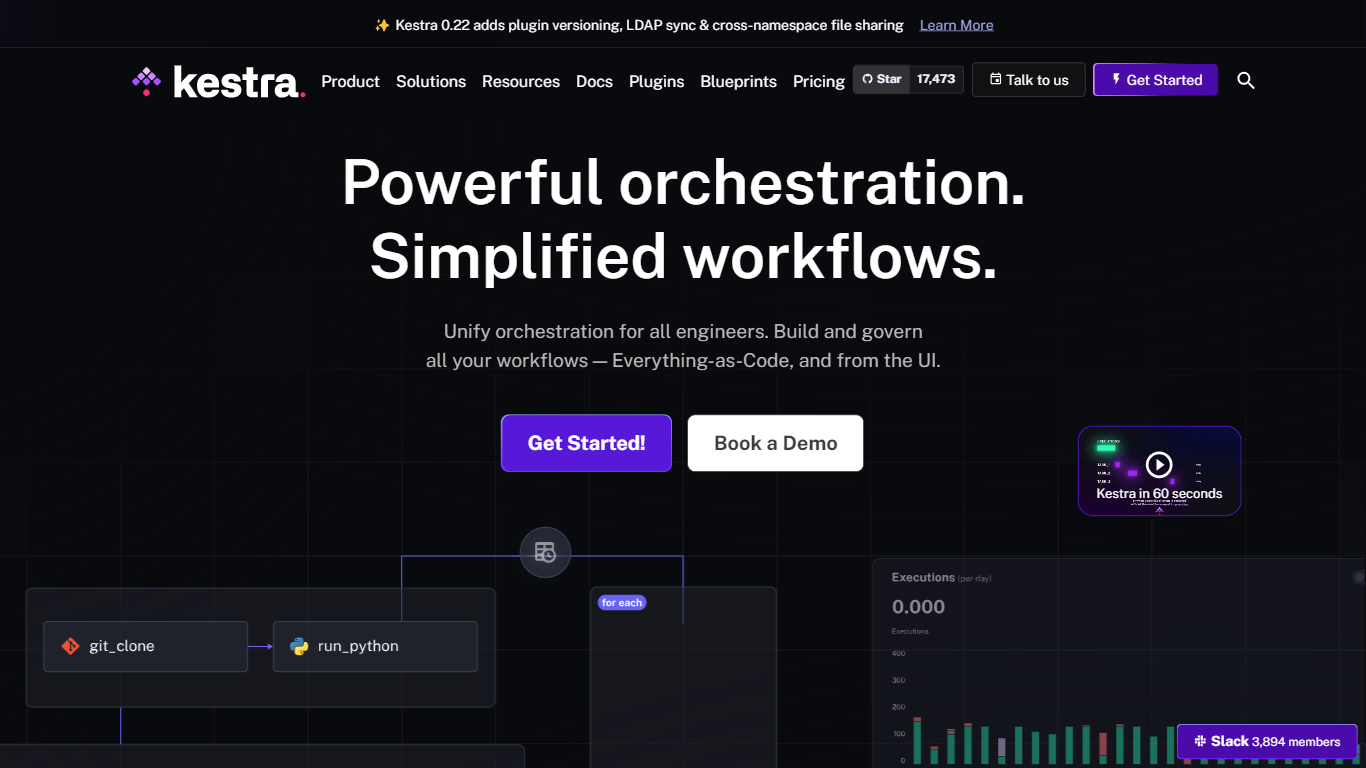
Last updated 04-25-2025
Category:
Reviews:
Join thousands of AI enthusiasts in the World of AI!
Kestra
Kestra is an open-source declarative orchestration platform designed to simplify the creation and management of data pipelines. Its core functionality revolves around enabling users to build workflows using a declarative language, which allows for easier scaling and flexibility. This platform is particularly beneficial for data engineers, software engineers, and platform engineers who need to automate processes, orchestrate data pipelines, and manage infrastructure efficiently. By providing a user-friendly interface and powerful capabilities, Kestra empowers teams to streamline their workflows and enhance productivity.
The target audience for Kestra includes data engineers who need to orchestrate complex data pipelines, software engineers looking to simplify their deployment processes, and platform engineers tasked with automating and optimizing infrastructure. The platform's unique value proposition lies in its ability to separate business logic from orchestration logic, allowing users to focus on their specific tasks without getting bogged down by the intricacies of orchestration. This separation enhances collaboration among team members, as both technical and non-technical users can engage with the platform effectively.
One of the key differentiators of Kestra is its event-driven architecture, which supports real-time processing and millisecond latency. This feature is crucial for industries that require immediate data processing, such as healthcare and retail. Additionally, Kestra's language-agnostic approach allows users to write business logic in various programming languages, making it adaptable to different team skill sets and project requirements. The platform also boasts a rich library of plugins and blueprints, enabling users to jump-start their workflows and integrate seamlessly with existing systems.
From a technical implementation perspective, Kestra is built to run anywhere—on-premises, in hybrid environments, or in the cloud—without the need for complex installations. It supports Infrastructure as Code (IaC) principles, allowing users to define their workflows in YAML and manage resources through tools like Terraform. This flexibility ensures that organizations can deploy Kestra in a way that best fits their infrastructure and operational needs.
Overall, Kestra stands out as a powerful orchestration platform that simplifies workflow management while providing the scalability and flexibility required by modern data-driven organizations. Its open-source nature fosters community collaboration and continuous improvement, making it a compelling choice for teams looking to enhance their orchestration capabilities.
Declarative Orchestration: Kestra allows users to define workflows using a simple declarative language, making it easier to manage and scale data pipelines without complex coding.
Event-Based Triggers: Users can configure workflows to run based on specific events, schedules, or APIs, ensuring timely execution of tasks and processes.
Language Agnostic: Kestra supports writing business logic in multiple programming languages, allowing teams to use the tools they are most comfortable with.
Integration with Third-Party Services: The platform offers over 600 plugins to connect with various systems and applications, simplifying the automation of diverse processes.
User-Friendly Interface: Kestra provides a no-code interface that enables non-technical users to engage with workflows, promoting collaboration across teams.
1) What is Kestra?
Kestra is an open-source declarative orchestration platform that helps users build and manage data pipelines easily.
2) Who can use Kestra?
Kestra is designed for data engineers, software engineers, and platform engineers who need to automate processes and orchestrate workflows.
3) What programming languages does Kestra support?
Kestra allows users to write business logic in various programming languages, including Python, R, Java, and more.
4) Can I run Kestra on any infrastructure?
Yes, Kestra can be deployed on-premises, in hybrid environments, or in the cloud without any installation headaches.
5) What are event-based triggers in Kestra?
Event-based triggers allow users to configure workflows to run based on specific events, schedules, or APIs, ensuring timely execution.
6) How does Kestra help with collaboration?
Kestra's user-friendly interface allows both technical and non-technical users to engage with workflows, promoting teamwork and collaboration.
7) Is Kestra free to use?
Yes, Kestra is an open-source platform, which means it is free to use and can be customized as needed.
